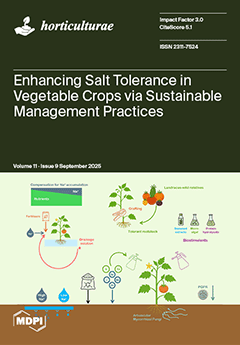Climate change, marked by increasing temperatures and unpredictable rainfall, presents a significant challenge to the sustainable cultivation of runner beans (
Phaseolus coccineus L.). These conditions underscore the urgent need for efficient resource management. Therefore, it is crucial to establish suitable irrigation regimes
[...] Read more.
Climate change, marked by increasing temperatures and unpredictable rainfall, presents a significant challenge to the sustainable cultivation of runner beans (
Phaseolus coccineus L.). These conditions underscore the urgent need for efficient resource management. Therefore, it is crucial to establish suitable irrigation regimes and nutritional conditions for runner bean cultivars. Furthermore, since genotype performance is strongly influenced by water availability and nutrient supply, understanding their interactive effects is essential for developing technologies that are adapted to climate change and sustain high yields of garden beans. In this context, the individual and combined effects of three runner bean cultivars (Cozia1, Cozia2, and Cozia3), two irrigation regimes (2000 and 2500 m
3·ha
−1), and three fertilisation strategies (chemical, organic, and unfertilised) on some physiological, morphological, and biochemical parameters were assessed in this study. The field experiment was carried out in the north-eastern part of Romania over two consecutive growing seasons, following a randomized split–split plot design with three replications. The results showed that genotype had the most significant influence on the majority of traits, highlighting its dominant role over fertilization and irrigation. Under chemical fertilization and 2500 m
3·ha
−1 irrigation, Cozia2 achieved the highest grain yield (3427.60 kg·ha
−1) and pod number (48.13), while Cozia1 combined with chemical fertilization under 2000 m
3·ha
−1 irrigation recorded the highest total phenolic content (0.47 mg GAE·100 g
−1 d.w.). Among cultivars, Cozia2 was highly responsive to fertilisation and irrigation variation, showing both the highest and lowest values for pod number, seed weight, and seeds per pod depending on treatment. Notably, the highest photosynthetic assimilation rates were observed in Cozia2 × IR2 × UF and Cozia3 × IR1 × OR combinations. Based on the results of this study, Cozia3 under chemical fertilization is best suited for high yields under limited water (2000 m
3·ha
−1), while Cozia2 is best suited when chemical fertilization is combined with higher irrigation (2500 m
3·ha
−1). However, in the context of organic cultivation, Cozia3 is identified as the most suitable cultivar.
Full article





